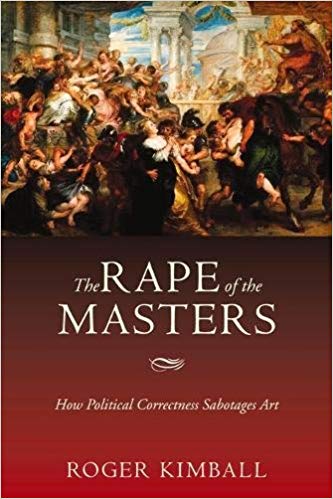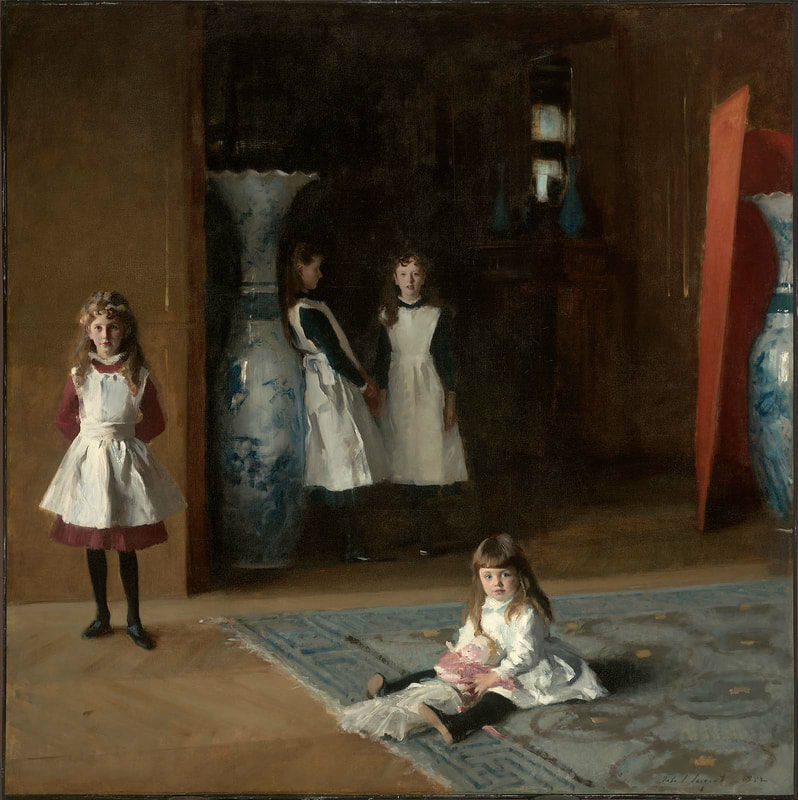|
Roger Kimball's book The Rape of the Masters: How Political Correctness Sabotages Art was a fun, quick read from cover to cover. If you have ever been subjected to recent art criticism, this book provides catharsis. With humor and wit, Kimball confronts the obfuscating rhetoric that clothes political agendas -- not with his own competing rhetoric and agenda but by trying to let the artwork speak for itself. Whereas so-called art critics, bedecked as they are with prestige, institutional backing, and economic privilege, tend to flabbergast, intimidate, and discourage, Kimball encourages his readers to take a step back, have a good laugh at what currently passes for academic art insight, and counter it with a good dose of common sense. He often quotes artists themselves, as well as their contemporaries, to provide a clearer view of how they understood each artwork under discussion. Kimball considers a number of cases of art criticism that he assures us are representative of the current practices in the field (rather than outliers or exceptions), systematically exposing them and de-jargonizing them while diagnosing the intellectual diseases at work in each case. Having been through a number of college art history courses at a prestigious university, I can attest that his selection of texts certainly is representative of the fare foisted upon my classmates and I. One of my favorite instances here is a perfectly ridiculous text on "The Daughters of Edward Darley Boit," a beautiful group portrait by John Singer Sargent. The art historian who penned the text, one Professor Lubin, wanders so far afield that he starts reading perverse sexual meaning into words that don't even appear in the painting or in the title of the painting, but only in the pun on the title that the author admits to fabricating himself and that would have never occurred to the artist or the patron. It is in this bizarre way that he purports to "find" the meaning inherent in the artwork. From the book: "Professor Lubin's first point is that the French word for box, boîte, is only one letter and an accent mark away from the surname of the painting's subject: "Boit." "The Boit Children makes a visual-verbal pun by translating into Les Enfants de (la)Boît(e): the children of Boit and the children of the box." In fact, it is not the painting that makes the pun - and a silly enough pun it is - but Professor Lubin. And that's just the beginning of the charade.... "Professor Lubin readily admits that "It far oversteps the bounds of credibility to think that Sargent had any of this in mind before, during, or after he painted the painting." "For this relief, much thanks"! (Hamlet I:1) But then he cheerfully tells us that, notwithstanding what Sargent thought, we shouldn't be surprised "if somehow a psychic transfer or transmutation occurs between the verbal part of the creative mind... and the visual part." Psychic transfer? Transmutation? What is this, Shirley MacLaine meets art history?" Kimball quotes Lubin at length as the latter goes on (and on) about vagaries of the significant connections between certain - ahem - anatomical parts and the uppercase and lowercase of the letter 'e' (because -- don't forget! -- the letter 'e' is conspicuously absent from the name in the title of this painting! Following this?). All he has to do here to reveal Lubin's absurdity to the sound-minded is simply to quote him! In short, Kimball has done a wonderful service: He selects representative tests of art criticism, translates them for his reader in the context of the real work, the practices of the artist, and his times, and calls them out for what they are: self-serving academic and political garble dressed up in very fancy pseudo-psychology, pseudo-philosopy, and, most of all, just words, words, words... Words that ultimately obscure the paintings they purport to describe. Kimball continues on more witty and enlightening jaunts with paintings by Courbet, Rubens, Winslow Homer, and van Gough and their critical aggressors, valiantly defending the honor of the masters along the way. While he does a delightful job of pointing out the ridiculous aspects of the current state of art criticism and the intellectual rot that has for a long time posed as learning, I do dock Kimball a few points for trying to enlist to his aid a number of artists and critics who are complicit in this decay. For example, Kimball amusingly rips apart a piece of art criticism or two dealing with the canvases of Marc Rothko, but not before a few pages of dedicated to apparently serious appreciation of that painter. He seems to accept, if not validate, Rothko's place in the canon of Western Art as written by the very critics and academics he is lampooning. Rothko's current prestige and place in the art world relies almost solely on the basis of the ridiculous climate of the arts made possible by the decay of common sense and the love of beauty. The only way Rothko can be so highly revered as he currently stands is through the rejection of beauty and the acceptance in its place of fatuous theory and political jockeying.
Kimball also tries to enlist Clement Greenberg as an ally in his interpretation of Paul Gauguin without putting Greenberg in his proper context as one of the primary founders of the strains of art history attempting to do away with beauty as a central theme in understanding art. In fact, Greenberg himself was one of the first critics to reject the beautiful representation of volumetric form in paintings as meritorious and in its stead have a theory of art that valued "flatness" per se. This of course flies in the face of the tradition of Western painting which, from the time of Leonardo and even before, considered the beautiful and accurate rendering of three dimensional form one of the key marks of beauty and indicators of the accomplishment of an artist. For readers interested in the subject of art history and those looking for further entertainment along these lines, I recommend Tom Wolf's The Painted Word to understand the earlier stages of the sickness of the art world and gain a broader critique of certain facts that Kimball either takes for granted or doesn't recognize as part of the problem. Overall The Rape of the Masters proves clarifying, fun, and refreshing. I would heartily recommend it to anyone, especially those who deal with art critics or interact with the art world establishment in any way. From the author himself: "... I hope that The Rape of the Masters will provide some inoculation against academic intimidation. The claims made by the critical marauders I discuss in this book are so outlandish, and they are typically expressed in language that is so rebarbative, that many people are stunned into acquiescence or at least into silence. It pleases me to think that The Rape of the Masters will help counteract that anesthesia, prompting more people to object to the objectionable." I think that Kimball's book will bear out these hopes admirably. Students in particular, approaching the discussion of art within mainstream academia or other art criticism circles, will do well to arm themselves with this work before undergoing the mental assault typical of the field. I wish I had been thus armed myself. What do you think? Does art criticism intimidate you? Do you have a hard time with interpretations of paintings that seem to be irrelevant to what's actually on the canvas?
2 Comments
|
AuthorHello there, I'm John H. Folley, an oil painter in the Boston School tradition. Thanks for visiting the Beauty Advocacy Blog, where it's my job to help you become a more discerning art appreciator. Connect with John:
Categories
All
Archives
February 2024
|


